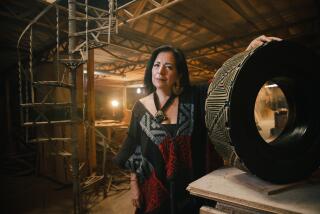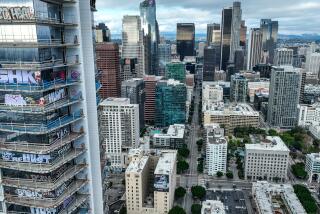A Shared Vision
- Share via
There’s no mistaking it. “The Mother and Child” by John Wilson bears a striking resemblance to “Madre y Nino” by Diego Rivera. Just as Hale Woodruff’s depiction of an uprising aboard a Spanish slave ship brings to mind Rivera’s “The Conquest of Mexico.”
Wilson and Woodruff, like a number of other noted African American artists of their day, traveled to Mexico about 50 years ago to learn from the masters of murals. Their journeys represent another example of a cultural exchange that gets lost in today’s age of ethnic tension.
“It’s through their works you can see the many similarities in cultures between blacks and browns,” said Jamesina Henderson, the executive director of the California African American Museum. “Even today, we have more that brings us together than pulls us apart.”
The museum sought to demonstrate some of the similarities Saturday when it opened its first bilingual exhibit featuring the works of eight African American artists and their Mexican mentors--the great muralists Rivera, Jose Clemente Orozco and David Alfaro Siqueiros.
Henderson said the exhibit, which is on a stop during a nationwide tour, has particular meaning at the museum’s Exposition Park home in the middle of a largely Latino and African American community. For years, the museum has emphasized the contribution of blacks to the arts.
“Now is the time, this is the time to do more,” Henderson said.
“In the Spirit of Resistance: African-American Modernists and the Mexican Muralist School” is on view through Aug. 17. It was organized by The American Federation of Arts and funded by the Philip Morris Co.
Lizzetta LeFalle-Collins, the guest curator who put the show together, said the works emphasize “common themes that are important in both African American and Latino cultures--strength of family, spirituality and resistance to tyranny and oppression.”
With sketches for murals, easel paintings, prints and sculptures, the exhibit features about 85 works by African American artists and 15 comparative works by Mexican artists from the 1930s to the 1950s.
*
“It’s an exhibit that is important because it shows new research,” said Thomas C. Padon, the director of exhibition for The American Federation of Arts, who flew in from New York City for the opening.
African American artists selected for the exhibit--Charles Alston, John Biggers, Elizabeth Catlett, Sargent Claude Johnson, Jacob Lawrence, Charles White, Wilson and Woodruff--all were so moved by the muralists’ powerful statements against oppression and fascism that they traveled to Mexico.
“We hear so much about the French influence on American artists,” LeFalle-Collins said. “The mural movement in Mexico grew out of the Mexican Revolution in 1910 and spread to the United States when the artists came here years later to paint their murals.”
Identifying with the plight of the peasants depicted in the murals, African American artists began to paint images of their segregated experiences in terms influenced by Mexican artists.
LeFalle-Collins said that Catlett’s portrait of freedom fighter Harriet Tubman is reminiscent of Francisco Mora’s picture of Emiliano Zapata.
“There is a lot we share in common,” said Juan G. Garcia, president of California Hispanic Publishers Assn., one of the co-sponsors of the event.
The museum kicked off the opening Saturday with Latin/Jazz music performed by a group composed of African Americans and Latinos. “In all forms of art we have a common ground,” said Hal “Taumbu” Ector, a conga drummer from South-Central Los Angeles who is the band’s director.
Jeff Rangel, 30, was intrigued by the artistic connections that Latinos and African Americans have shared since the muralists.
“It seems that we have influenced each other,” said Rangel, who is working on his doctorate in Latino studies. “I find it interesting that Charles White, who learned from the muralists, taught what he learned to young Chicano artists in Los Angeles.”
But Johann Hassan, an art instructor at Jefferson High School, was not surprised that Latinos and blacks had a shared experience in the arts.
“Artists are always influenced by other artists,” she said, walking through the exhibition. “The important thing is that they retain their own flavor, their own style.”
Victor Mendez, a writer for a Spanish-language newspaper, said he appreciated the works of artists from the past but wanted to know more about how artists today are finding similar avenues of expression.
“Civil rights laws have been passed, racism has changed, the problems are more sophisticated,” he said. “I want to know how artists are dealing with that today.”
But for John Trevino, 25, there was still plenty to learn from the masters, both African American and Mexican.
He was stunned by White’s “Sharecropper.” He examined it so closely that his nose almost touched the canvas, then he stepped back to take a different view. There was the large thumb on the right hand, bulging muscles on the arm, the bright greens that jumped out from the cornstalks. But most of all he was baffled. He couldn’t see any brush strokes.
“How does he do it?” said Trevino. “It’s like spreading so much butter on toast that you don’t see the grains of bread. It’s amazing.”
More to Read
The biggest entertainment stories
Get our big stories about Hollywood, film, television, music, arts, culture and more right in your inbox as soon as they publish.
You may occasionally receive promotional content from the Los Angeles Times.










